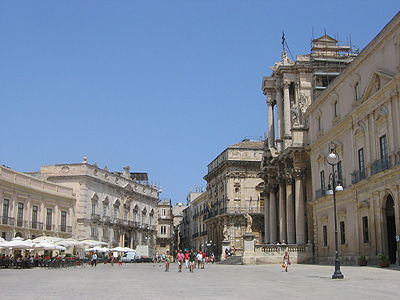SYRACUSE
In 734 BC,
some Greeks coming from Corinth,
guided by Archia, settled on the Island of Ortigia, founding
Syracuse, coming from a nearby swamp
called Syraka. But the Greeks had to drive away other
inhabitants who were present from the 15th Century
BC, probably Siculi.
The City became the second Greek colony of Sicily
and immediately enjoyed a period of commercial development,
so much so, that in a short time they founded a further three
colonies: Akrai in 664, Casmene
in 643 and Camarina in 598.
During the 6th Century, social clashes
ignited between the Gamoroi, descendants from the
first colonies and landowners, and the Killichirioi,
the poorer classes. The latter managed to drive away the nobles,
but intervention by Gelone, tyrant of Gela
(485 BC), re-established ancient social order
and allowed Gelone to become the tyrant of Syracuse.
Under his governing, the City grew and developed outside the
Island of Ortigia. After only 5 years, there was a clash between
the Carthaginians and the Greeks,
who won over the first mentioned in the Battle of
Imera (480 BC). To commemorate the
Battle, a Temple of the goddess Athena was erected in Ortigia,
transformed in modern times to today’s Cathedral.
Ierone, Gelone’s brother, came to power
in 478 BC, and defeated the Etruscans in
474 BC, in the waters of Cuma, stopping their expansion towards
the South.
His brother Trasibulo, who succeeded him,
only governed for one year (465 BC), as he
was driven away by the population for his violent politics.
Later on a democracy was established.
In 416 BC, due to events linked to the Peloponnesian
War, Athens moved their war to Syracuse.
The antecedent fact was the clash between Segesta,
a Athenian ally, and Selinunte,
allied to Syracuse, and in turn, allied to Sparta, therefore
adverse to Athens. The siege lasted 3 years and when Syracuse
was about to give up, it received help from the Spartan troops
of Gilippo, who defeated the Athenians and condemned the survivors
to hard labour in the Latomie or stone caves of Syracuse.
In 405 BC, Dionysius I came
to power, who, after stipulating peace with the Carthaginians,
fortified the Island of Ortigia and erected a 22km
wall around the City, and also erected the fortress
around the Eurìalo Castle. In 397
BC, after having conquered Catania
6 years earlier, Dionysius I resumed hostilities and defeated
the Carthaginians in 392 BC, therefore succeeding
in the initiation of expansionist politics in Sicily
and as sponsor of the arts: Platone was often a guest in the
City.
|
